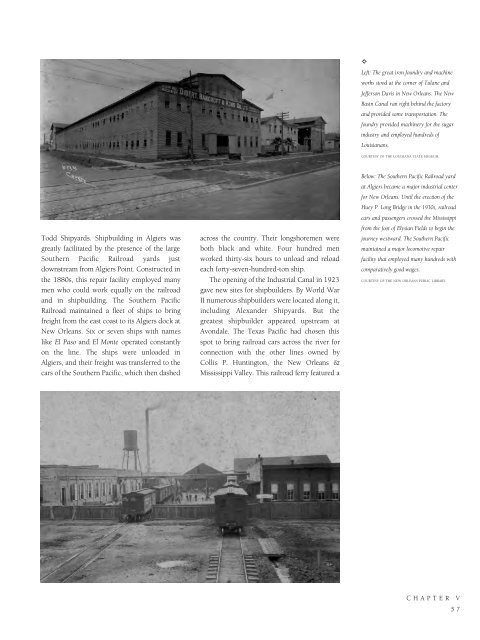Historic Louisiana
An illustrated history of Louisiana, paired with the histories of companies, families and organizations that make the state great.
An illustrated history of Louisiana, paired with the histories of companies, families and organizations that make the state great.
Create successful ePaper yourself
Turn your PDF publications into a flip-book with our unique Google optimized e-Paper software.
✧<br />
Left: The great iron foundry and machine<br />
works stood at the corner of Tulane and<br />
Jefferson Davis in New Orleans. The New<br />
Basin Canal ran right behind the factory<br />
and provided some transportation. The<br />
foundry provided machinery for the sugar<br />
industry and employed hundreds of<br />
<strong>Louisiana</strong>ns.<br />
COURTESY OF THE LOUISIANA STATE MUSEUM.<br />
Todd Shipyards. Shipbuilding in Algiers was<br />
greatly facilitated by the presence of the large<br />
Southern Pacific Railroad yards just<br />
downstream from Algiers Point. Constructed in<br />
the 1880s, this repair facility employed many<br />
men who could work equally on the railroad<br />
and in shipbuilding. The Southern Pacific<br />
Railroad maintained a fleet of ships to bring<br />
freight from the east coast to its Algiers dock at<br />
New Orleans. Six or seven ships with names<br />
like El Paso and El Monte operated constantly<br />
on the line. The ships were unloaded in<br />
Algiers, and their freight was transferred to the<br />
cars of the Southern Pacific, which then dashed<br />
across the country. Their longshoremen were<br />
both black and white. Four hundred men<br />
worked thirty-six hours to unload and reload<br />
each forty-seven-hundred-ton ship.<br />
The opening of the Industrial Canal in 1923<br />
gave new sites for shipbuilders. By World War<br />
II numerous shipbuilders were located along it,<br />
including Alexander Shipyards. But the<br />
greatest shipbuilder appeared upstream at<br />
Avondale. The Texas Pacific had chosen this<br />
spot to bring railroad cars across the river for<br />
connection with the other lines owned by<br />
Collis P. Huntington, the New Orleans &<br />
Mississippi Valley. This railroad ferry featured a<br />
Below: The Southern Pacific Railroad yard<br />
at Algiers became a major industrial center<br />
for New Orleans. Until the erection of the<br />
Huey P. Long Bridge in the 1930s, railroad<br />
cars and passengers crossed the Mississippi<br />
from the foot of Elysian Fields to begin the<br />
journey westward. The Southern Pacific<br />
maintained a major locomotive repair<br />
facility that employed many hundreds with<br />
comparatively good wages.<br />
COURTESY OF THE NEW ORLEANS PUBLIC LIBRARY.<br />
CHAPTER V<br />
57
















